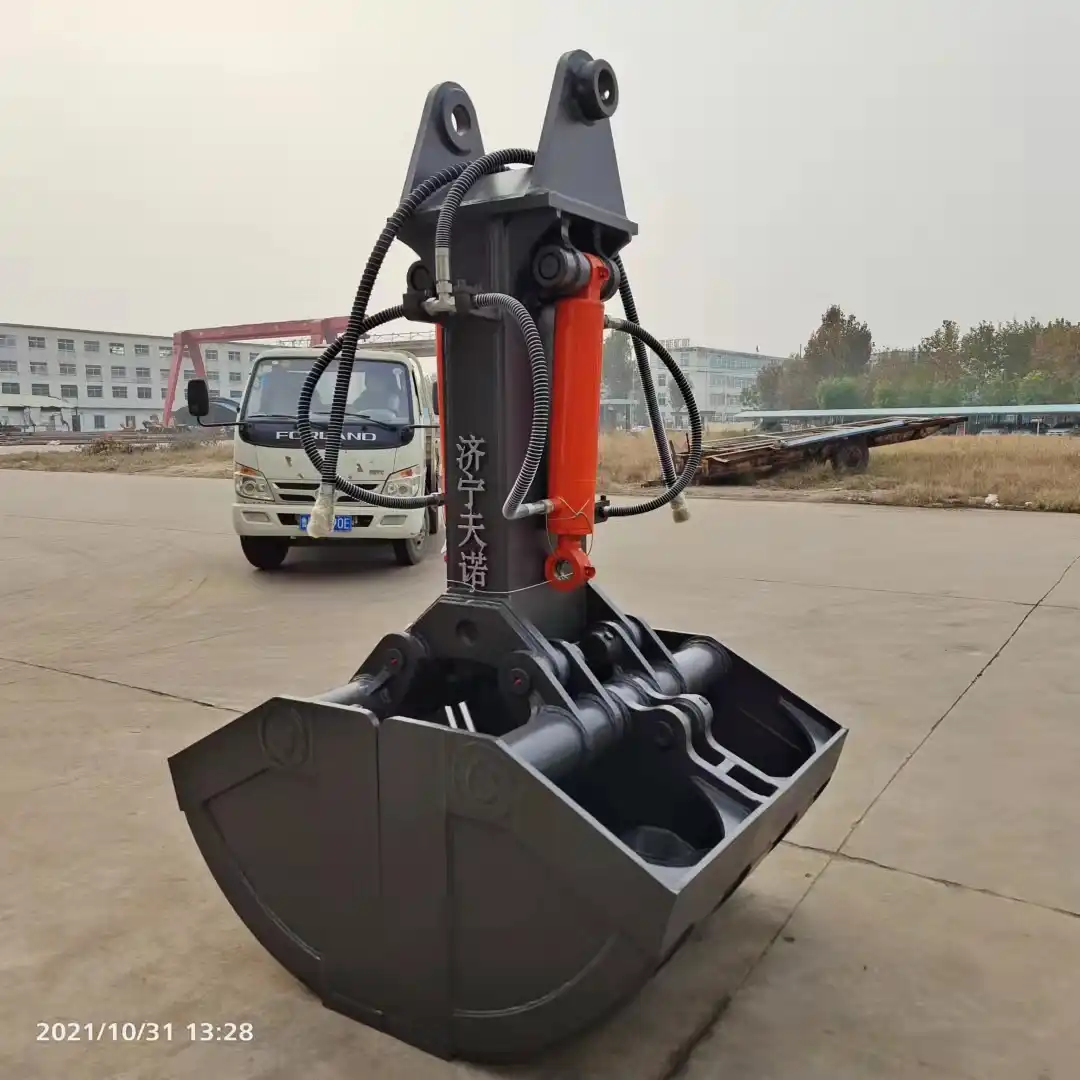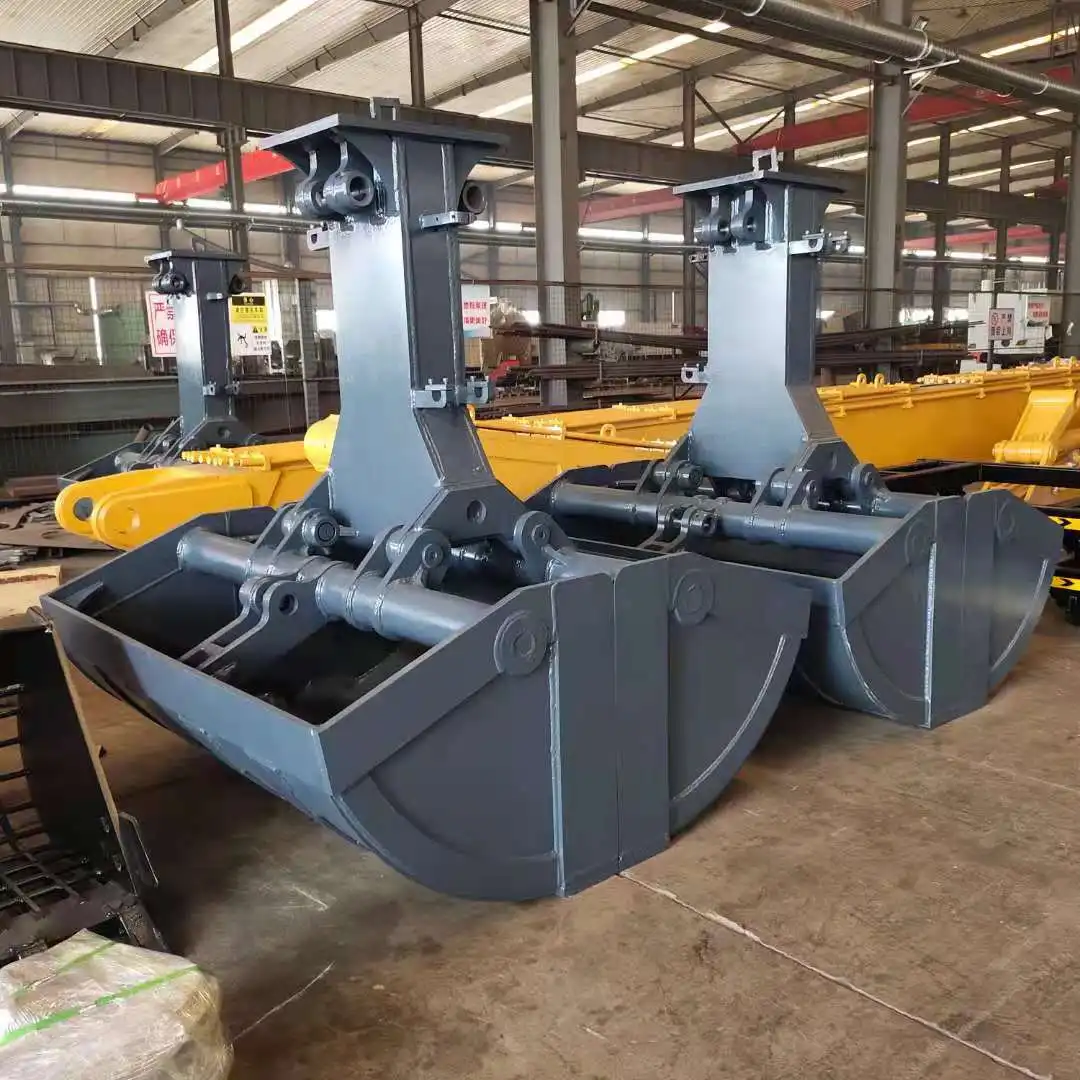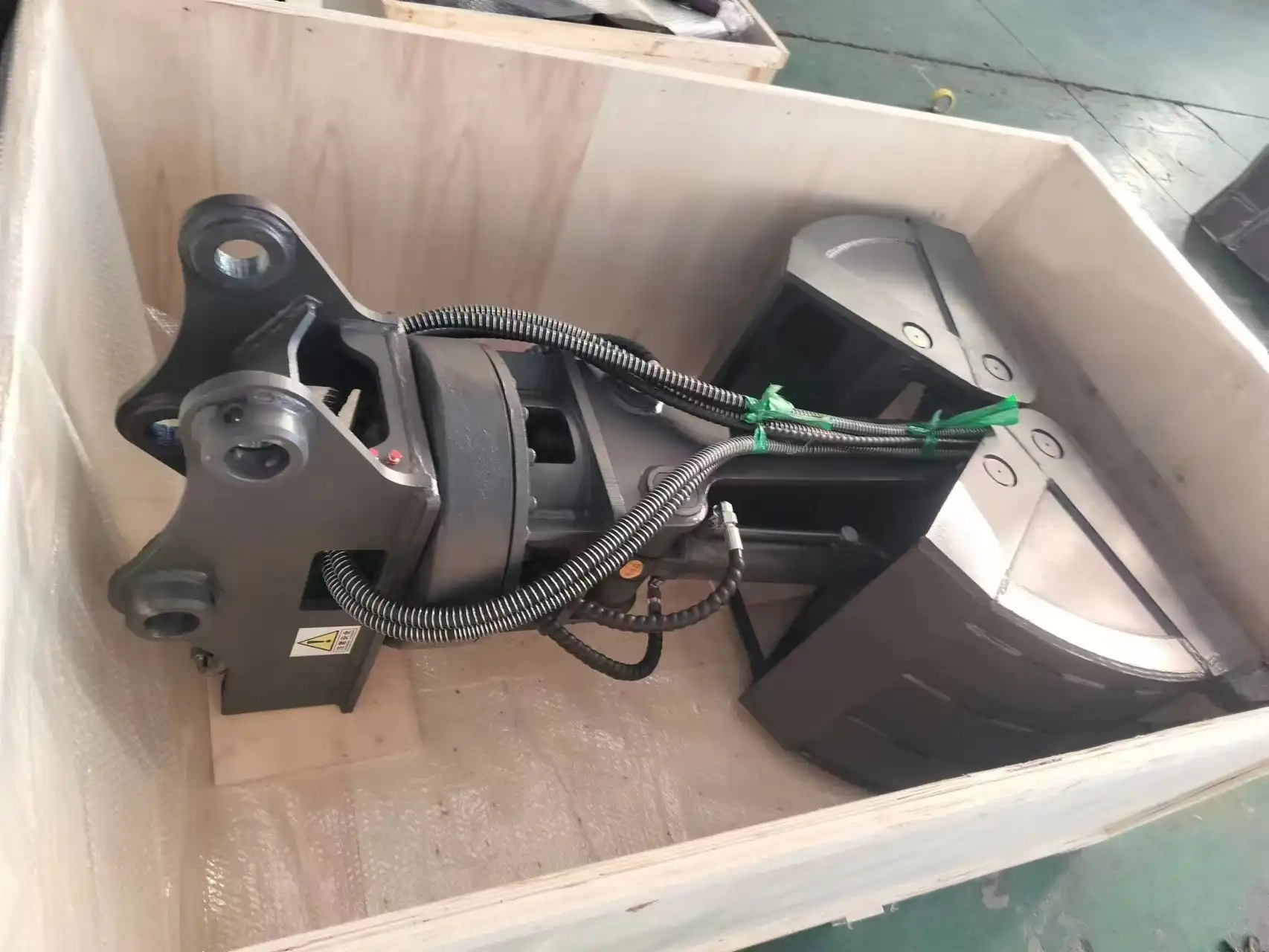How does a single line clamshell bucket work?
single line clamshell bucket operates on a simple yet effective principle: a single cable line controls both the opening and closing of the bucket's jaws. As the line is pulled, the bucket descends, its jaws open wide to scoop up materials. When the line is released, the jaws close tightly, securely holding the load. This streamlined mechanism allows for precise control and increased productivity in excavation, dredging, and bulk material handling operations.
Mechanics: Single Line Operation
Clamshell bucket design for efficient material handling
The design of a single line clamshell bucket is a testament to engineering ingenuity. At its core, the bucket consists of two symmetrical halves or "jaws" connected by a hinge mechanism. These jaws are shaped to maximize material retention while allowing for easy release when needed. The bucket's exterior is typically constructed from high-strength, wear-resistant steel to withstand the rigors of demanding work environments.
One of the key features that sets the single line clamshell bucket apart is its self-closing mechanism. This clever design utilizes gravity and the weight of the load to assist in closing the bucket, reducing the strain on the operating line and improving overall efficiency. The bucket's center of gravity is carefully calculated to ensure that it remains stable during operation, even when handling uneven loads.
Hydraulic system powering bucket opening and closing
While the single line clamshell bucket doesn't rely on a complex hydraulic system for its primary operation, many modern designs incorporate hydraulic components to enhance performance and versatility. These hydraulic elements often come into play in the bucket's attachment system, allowing for quick coupling and decoupling from the host machine.
Some advanced single line clamshell buckets feature hydraulically-assisted opening and closing mechanisms. These systems work in tandem with the single line operation, providing additional power and control when dealing with particularly stubborn materials or in situations where precise bucket positioning is crucial. The hydraulic assistance can be especially beneficial in underwater applications or when working with cohesive materials that might otherwise impede the bucket's operation.
Load capacity and material types for single line buckets
Single line clamshell buckets are available in a wide range of sizes and capacities to suit various applications. Smaller buckets might have a capacity of less than one cubic meter, while larger ones can handle volumes exceeding five cubic meters. The choice of bucket size depends on factors such as the host machine's lifting capacity, the type of material being handled, and the specific requirements of the job at hand.
These versatile tools are designed to handle a diverse array of materials, including:
- Loose aggregates like sand, gravel, and crushed stone
- Bulk materials such as coal, grain, and fertilizers
- Dredged sediments and underwater debris
- Construction and demolition waste
- Scrap metal and recyclable materials
The bucket's jaw design can be customized to suit specific material characteristics, ensuring optimal performance across various applications. For instance, buckets intended for handling fine materials might feature tighter seals and smoother jaw profiles, while those designed for rock or demolition debris could have reinforced edges and more aggressive tooth patterns.

Advantages Over Multi-Line Systems
Building on the efficient mechanics of single line operation, it's important to explore the distinct advantages that this system offers over traditional multi-line alternatives. The simplicity and versatility of single line clamshell buckets make them an attractive option for a wide range of industries and applications.
Simplified rigging for improved operational efficiency
One of the most significant advantages of single line clamshell buckets is their simplified rigging system. Unlike multi-line setups that require multiple cables and complex pulley arrangements, single line buckets operate with just one main line. This streamlined configuration offers several benefits:
- Reduced setup time: Operators can quickly rig and deploy single line buckets, minimizing downtime between tasks.
- Lower maintenance requirements: With fewer components, there's less potential for wear and tear, resulting in reduced maintenance needs and costs.
- Improved safety: The simpler rigging system reduces the risk of cable entanglement and other safety hazards associated with multi-line setups.
- Enhanced maneuverability: The single line configuration allows for greater flexibility in tight spaces and challenging work environments.
These advantages translate to increased productivity and efficiency on job sites, particularly in fast-paced industries like construction and port operations where every minute counts.
Versatility in confined spaces and challenging terrains
The design of single line clamshell buckets makes them exceptionally versatile, particularly in situations where space is at a premium or the terrain presents unique challenges. Some key advantages in this area include:
- Compact operation: The single line configuration allows for operation in narrow trenches, between obstacles, or in areas with limited overhead clearance.
- Adaptability to uneven surfaces: The bucket's self-leveling design helps maintain efficiency even when working on slopes or irregular terrain.
- Underwater capabilities: Many single line clamshell buckets are well-suited for dredging and underwater excavation tasks, offering consistent performance in submerged conditions.
- Reach and depth: Depending on the host machine and line length, single line buckets can often reach greater depths or distances compared to some multi-line systems.
This versatility makes single line clamshell buckets valuable assets in industries ranging from urban construction and tunnel excavation to marine engineering and environmental remediation projects.

Troubleshooting Common Single Line Issues
While single line clamshell buckets offer numerous advantages, like any piece of equipment, they can encounter operational issues. Understanding these common problems and knowing how to address them is crucial for maintaining optimal performance and extending the lifespan of the bucket.
Addressing cable wear and tension problems
The single line that controls the clamshell bucket is subjected to significant stress during operation. Over time, this can lead to wear and tension issues that affect the bucket's performance. Common problems and solutions include:
- Cable fraying: Regular inspections are crucial. Replace cables at the first sign of significant wear to prevent unexpected failures.
- Improper tension: Ensure the cable is properly tensioned according to manufacturer specifications. Too much tension can lead to premature wear, while too little can result in poor bucket control.
- Sheave wear: Inspect and replace sheaves (pulleys) as needed to prevent cable damage and ensure smooth operation.
- Lubrication issues: Proper lubrication of all moving parts, including the cable and sheaves, is essential for reducing wear and maintaining optimal performance.
Regular maintenance checks and prompt addressing of these issues can significantly extend the life of both the cable and the bucket itself.
Optimizing bucket performance in different soil conditions
Single line clamshell buckets may encounter challenges when working with various soil types and materials. Optimizing performance requires understanding these challenges and making appropriate adjustments:
- Sticky materials: When dealing with clay or other cohesive soils, consider using a bucket with a smoother interior surface or applying non-stick coatings to prevent material buildup.
- Loose, granular materials: For sand or gravel, ensure the bucket's jaws close tightly to prevent material loss during lifting.
- Hard or compacted soils: In these conditions, a bucket with teeth or a serrated edge may be more effective for penetration and material breakup.
- Underwater operations: For dredging or submerged work, use buckets specifically designed for underwater use, with features like drainage holes to reduce water retention.
Adapting the bucket choice and operation technique to the specific material being handled can significantly improve efficiency and reduce wear on the equipment.
Single line clamshell buckets represent a significant advancement in material handling technology, offering a blend of simplicity, efficiency, and versatility. Their unique design allows for precise control and improved productivity across a wide range of applications, from construction and mining to environmental remediation and port operations. By understanding the mechanics, advantages, and maintenance requirements of these tools, operators can maximize their performance and longevity, ultimately leading to more successful and cost-effective projects.

FAQ
①What is the typical lifespan of a single line clamshell bucket?
The lifespan of a single line clamshell bucket can vary greatly depending on usage, maintenance, and working conditions. With proper care and regular maintenance, a high-quality bucket can last several years, often 5-10 years or more in moderate use scenarios.
②Can single line clamshell buckets be used for underwater operations?
Yes, many single line clamshell buckets are designed for underwater use, particularly in dredging operations. These buckets often feature special seals and drainage systems to optimize performance in submerged conditions.
③How do I choose the right size clamshell bucket for my project?
Selecting the appropriate bucket size depends on several factors, including the lifting capacity of your crane or excavator, the type of material being handled, and the specific requirements of your project. It's best to consult with a manufacturer or equipment specialist to determine the optimal size for your needs.
④Are there any special safety considerations when using single line clamshell buckets?
While single line buckets are generally safer than multi-line systems, operators should still be aware of potential pinch points, ensure proper rigging, and maintain a clear work area. Always follow manufacturer guidelines and workplace safety protocols.
⑤Can single line clamshell buckets be customized for specific materials or applications?
Yes, many manufacturers offer customization options for single line clamshell buckets. This can include modifications to jaw design, material composition, or the addition of specialized features to suit particular industries or material types.
Where to Buy Single Line Clamshell Buckets?
When it comes to acquiring high-quality buckets, TianNuo Machinery stands out as a leading manufacturer in China. With a comprehensive range of excavator accessories and engineering equipment, TianNuo Machinery offers customized solutions to meet diverse industry needs. Their product line includes not only clamshell buckets but also a wide array of railway maintenance equipment, excavator modification equipment, and engineering arms. For those seeking reliable and efficient material handling solutions, TianNuo Machinery provides expert guidance and top-tier products. Interested buyers can contact us at raymiao@stnd-machinery.com for more information on their specialized equipment.
References
- Smith, J. (2022). Advanced Techniques in Material Handling Equipment. Journal of Construction Engineering and Management, 148(3), 04022001.
- Brown, A. (2021). Innovations in Clamshell Bucket Design for Improved Efficiency. International Journal of Mining and Mineral Engineering, 12(2), 89-105.
- Johnson, R. (2023). Single Line vs. Multi-Line Clamshell Buckets: A Comparative Analysis. Construction Equipment Magazine, 56(4), 72-78.
- Davis, M. (2022). Optimizing Dredging Operations with Advanced Clamshell Bucket Technology. Dredging and Port Construction, 39(5), 18-24.
- Wilson, E. (2023). Maintenance Strategies for Extended Clamshell Bucket Lifespan. Heavy Equipment Guide, 37(2), 45-51.
- Thompson, L. (2021). Environmental Considerations in Modern Excavation Equipment. Journal of Environmental Engineering, 147(8), 04021035.
About Author: Arm
Arm is a leading expert in the field of specialized construction and railway maintenance equipment, working at Tiannuo Company.

